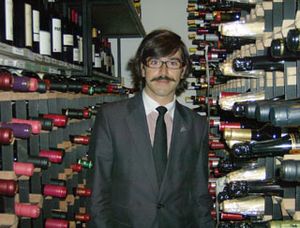Hailing from Spain's Ribera del Duero, Rubén Sanz Ramiro brings his warmth and adventurous spirit to New York's Monday Room as its Wine Steward. His prior work experience includes stints at Heston Blumenthal's Fat Duck, where he worked with a list of 1,500 titles and matched wines with chef Blumenthal's unique renditions of molecular gastronomy; and at The Providores with chef Peter Gordon, where got a solid grounding in the food and wine of New Zealand. For The Monday Room, Ramiro seeks out bottles distinguished by expert winemaking and distinct expression of terroir, often exploring lesser-known regions and producers, ensuring that his customers are always in for a surprise.
One of the great pleasures in moving from London to New York to work with Public and its sister restaurant, the Monday Room, has been collaborating with chef Brad Farmerie. Brad’s enthusiasm for Australian food and wine is infectious, and it has led me on my own path of discovery, giving me the chance to learn more about the hidden gems of this country’s wines.
When we think about premium Australian wines, we easily tend to think about reds. Shiraz, Cabernet Sauvignon, and old vine Grenache garner well-deserved attention and high scores from the critics, and adoration from consumers. However, it is Australia’s white wines, specifically those made from Riesling and Semillon, that I feel deserve special attention because in the hands of a talented winemaker, they are yield wines that have great class and a style that is not duplicated anywhere in the world, and, at the highest levels, are eminently age-able.
The Riesling style is bone dry, crisp, and steely and offers flavors of citrus fruit in its early ages. The wine, as the greatest Rieslings from other areas in the world, can age for decades, acquiring notes of toast, kerosene, honey and offer great levels of complexity. The finest Rieslings come from South Australia, most notably the regions of Clare Valley and Eden Valley, as well as some parts of Western Australia.
Clare Valley in the north offers the most distinctive style: dry, austere in the first years of its life, showing a firm structure, high acidity, and suggestions of lime flavors. After five or six years in the bottle the wine becomes softer, offering a complex palate and nose, with notes of riper fruit and toast. The region is broken into a series of sub-regions: Auburn, Clare, Leasingham, Polish Hill River, Seven Hill, Watervale, and White Hut. Within Clare, the wines of Polish Hill are characterized by a distinct minerality, while those from Watervale have a floral style thanks to the limestone-rich soil.
South of Clare Valley, and close to Barossa, is Eden Valley. Here Riesling is crafted in a style that is broader, being fuller and softer in the palate than the steely Rieslings from Clare. As in Clare, these wines truly benefit from aging, becoming really attractive as they mature.
Western Australia too has beautiful Rieslings, particularly those from the cool climate region of Great Southern, whose sub-regions of Frankland, Denmark, and Porongurup offer the most success growing for growing this grape. Like the Riesling from Clare or Eden, it ages perfectly, maybe reaching its peak earlier than in the sister regions in South Australia. The wine is quite austere in its youth having crisp acidity, a citrus fruit character, as well as herbaceous notes.
To find great Semillon, we move from Western Australia, across the continent, to New South Wales. Here, in the Hunter Valley we find the most northerly of Australia’s wine regions that produce some of the country’s most classically elegant yet under-appreciated wines. This hot climate region is divided in two areas, Upper and Lower Hunter, the latter producing some of the country’s better examples of Semillon. Here, Semillon is crafted in a traditional manner: the grapes are picked early for low ripeness; the must is fermented in stain steel vats; and the wines are bottled without malolactic fermentation.
The initial result is thin, grassy and almost painfully acidic; at this point the wine does not merit much attraction. Yet age it for around ten years during which time the wine will go through a magical transformation, emerging broader, rounder and with a constellation of flavors of toast, butter, nuts and honey. For the patient collector, Semillons from Hunter are an excellent investment.
Riesling and Semillon from Australia are in the “pole position” to be my favorite wines from Australia.
Jul 16, 2007
•
3 min read
The Australian Pearls by Rubén Sanz Ramiro, Wine Steward at the Monday Room

Table of Contents

Like to eat?
Subscribers get the goods.

